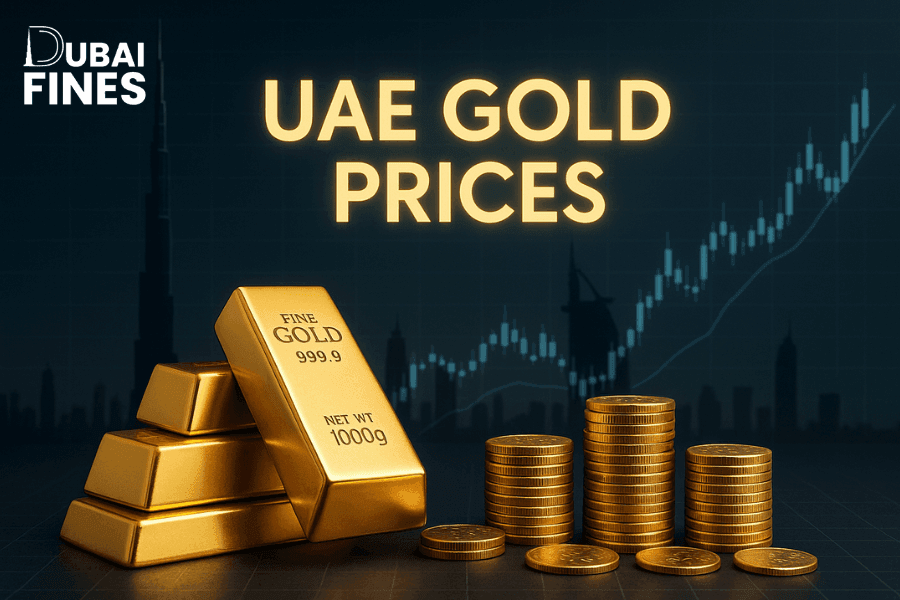UAE Gold Prices at Record Highs: Understanding the Global Drivers
The UAE gold prices have recently recorded new highs, reflecting a great global trend in the value of the precious metal. This upsurge in prices is not solely a local situation. The prices are high due to global economic uncertainty and strategic central bank purchases which are experienced throughout the Emirates. Gold plays a very important role as a safe-haven asset during geopolitical or financial tension.
The current upward trend in prices showed high short-term returns. According to the statistics, the price of 24K gold shot up by AED 448.25 per gram to AED 466.75 between September 23, 2025, and October 2, 2025. This is a growth of more than AED 18.50 within a span of nine days. The causes of this rally can be explained to inform both investors and consumers in the future.
Table of Contents
Global Factors Driving the Gold Price Rally
UAE Dirham (AED) has a fixed exchange rate against the US Dollar (USD). Thus, the domestic gold prices are directly related to the global spot price of gold. Certain research-based factors affect this world price. These elements ensure that investment and central bank demand continue to increase all around the world.
What is the main cause of the rise in gold demand?
International economic and political insecurity drives investors towards gold. Studies conducted by such schools as the Wharton School demonstrate that at times of high uncertainty, gold appeals are the strong ones among investors.
Gold does not have any counterparty risk as compared to a bond or other debt instruments. An expected growth of 15% was the result of high geopolitical tensions in 2024 on gold prices. By the time risky assets are volatile, gold continues to have a stable value.
What is the effect of central banks on the market?
The purchase of gold by the central banks is done in a very rapid manner. The purchases of central banks have surpassed 1,000 tonnes in three consecutive years. The motive behind these institutions’ purchasing gold is to diversify the national reserves and to reduce the dependency on the US Dollar. High prices of gold are supported by this long-term demand by governments.
How Fed affect the value of gold?
The Federal Reserve policy can impact the prices of gold through the value of the US Dollar and real interest rates. Real interest rates usually fall, which raises the price of gold since there is no interest, thus creating a rise in the price of gold. The lower rates make the opportunity cost of holding this non-yielding asset low. Gold prices were expected to improve as market anticipations showed that there would be two decreases in the Fed rates by the end of 2025.
Can inflation be a major source of the rise in prices?
Yes, gold served in the past as an inflation hedge. The price of gold rises when investors are confident that the future price of goods and services will rise. Higher expectations of inflation had a slight role in the surge in gold prices at the end of the year in January 2025. The possession of gold insures against the possible deflation of currency.
Price Performance and Consumer Behavior in the UAE
The UAE market trends are in tandem with the international trend. The increase is high in the short and long term. Gold continues to be a strategic investment or conventional buy because of the high cultural attachment of the people of the region to the metal.
What are the long-term statistics of UAE gold prices?
Gold reflects tremendous growth in the UAE in the last five years. The increase in gold prices expressed in AED per ounce was 42.50 percent in a year. The growth during a period of over five years was about 99.07. The continued performance is an endorsement of the fact that gold is an important primary financial asset.
What are the impacts of high prices on local jewelry purchases?
The high prices will decrease the amount of jewelry being sold. According to the data provided by the World Gold Council, the yearly consumption of jewelry in the world dropped by 11 percent in 2024. Nevertheless, the amount that was used in jewelry purchases still went up by 9 percent due to the increased prices. Customers buy less but place a greater value.
Do people in the UAE alter their gold purchasing habits?
Yes, the UAE market has a consumer adaptation and resilience in consumer habits. Retailers observed that there was a market shift to the smaller dual-purpose gold items. Such works serve as investment and decoration. With this strategic change, the market can be left active even in a scenario where the prices remain high.
Also Read: UAE Petrol Prices in October 2025 Announced
Understanding Gold Price Data
It is convenient to review some of the most important data points in relation to the prices of gold over time. Following is a simplified table that shows hypothetical daily changes in the price of gold in the UAE (assuming that gold is 24K and 1 gram of gold weighs 2400kg):
| Date (October 2025) | Global Spot Price (USD/ounce) | USD to AED Exchange Rate | UAE Gold Price (AED/gram 24K) | Daily Change (AED/gram) |
| Oct 1 | 1950 | 3.67 | 231.85 | +1.20 |
| Oct 2 | 1955 | 3.67 | 232.44 | +0.59 |
| Oct 3 | 1965 | 3.67 | 233.63 | +1.19 |
| Oct 4 | 1960 | 3.67 | 233.04 | -0.59 |
| Oct 5 | 1970 | 3.67 | 234.23 | +1.19 |
This table shows how global spot prices, combined with the exchange rate, determine the local UAE price. Small daily fluctuations reflect the dynamic nature of the market.
Gold as a Strategic Financial Asset
The fluctuations in the price of gold are mostly associated with its use in the financial market. The demand shift created by the private investors and central banks is much higher than the industrial consumption. Financial markets also saw a significant increase in the number of investors, especially Exchange Traded Funds (ETFs), which are backed by gold (since the early 2000s).
What makes gold a safe-haven asset?
Gold is considered a stable store of value, and it will not lose its value over a long duration. It is a zero-credit, physical asset. During a worldwide crisis or extreme market volatility, investors invest in gold to ensure their safety. Such high demand keeps pushing the price high.
What is dedollarisation and how does it drive gold?
In some of the emerging market central banks, plans out the accumulation of gold. They do so to diversify other than the US Dollar. This is referred to as dedollarisation and the trend is driven by geopolitical or macroeconomic reasons. Nations such as China and Russia were all upgrading their reserves of gold in large numbers with this strategic aim.
What are the main sources of global gold demand?
The world gold demand can be divided into four major types:
- Jewelry: This takes up about 50% of the demand, which is dominated by China and India.
- Investment: This will be approximately 25% of demand in coins, bars, and ETFs.
- Central Banks: This comprises around 20% of the demand for diversification of reserves.
- Technology: This adds about 5 percent to the demand for electronic and other applications.
| Country | 24K Price (Local Currency) | Equivalent (AED) |
| India | ₹11,924/gm | ~AED 525 |
| Saudi Arabia | SAR 238/gm | ~AED 233 |
| Oman | OMR 25.20/gm | ~AED 240 |
| Kuwait | KWD 24.80/gm | ~AED 295 |
Market Outlook and Investment Future
Recent price dynamics indicators indicate high positive momentum, which is a positive indicator of the continued flow of investment. There is a positive market feeling that gold is a long-term risk hedge. The high prices will continue so long as the uncertainty that surrounds the world monetarily and geopolitically is still high.
Will the recent high price run be sustained?
Structural factors that analysts would see as upholding high prices are identified. Constant demand is given by geopolitical tensions and long-term central bank purchasing. The World Gold Council is indicating that investment demand, and especially ETFs, is strong. The always-present global risk atmosphere is a consistent advantage to the price of gold.
What is the significance of the UAE market in the world?
The UAE market and the Dubai Multi Commodities Centre (DMCC) in particular, are essential international trading centres. The currency peg makes its prices closely follow the international spot price. Such transparency in prices and market relationships has highlighted the importance of the UAE in the world gold trade.
Does more gold supply cope with high demand?
The high prices are not accompanied by a lot of increased gold supply. Production in the mines is not projected to increase drastically, at only 1%-2%. The volume of recycling of gold was also rather unresponsive to the price stimulus. Supply is finding it hard to meet such powerful, strategic demand.
Conclusion:
The world has seen a gold rush, and UAE gold prices are at historic highs. The major factors are obviously central bank policy, increasing geopolitical risk and the possibilities of lower real interest rates. High institutional investment and retail investment demand strengthen the credibility of gold as a safe-haven.
The immediate market is also not insensitive as the consumers are adjusting to the expensive purchasing conditions. The background factors that led to this rally have deep entrenched roots in the global economic changes and are probably justifying further high prices.







